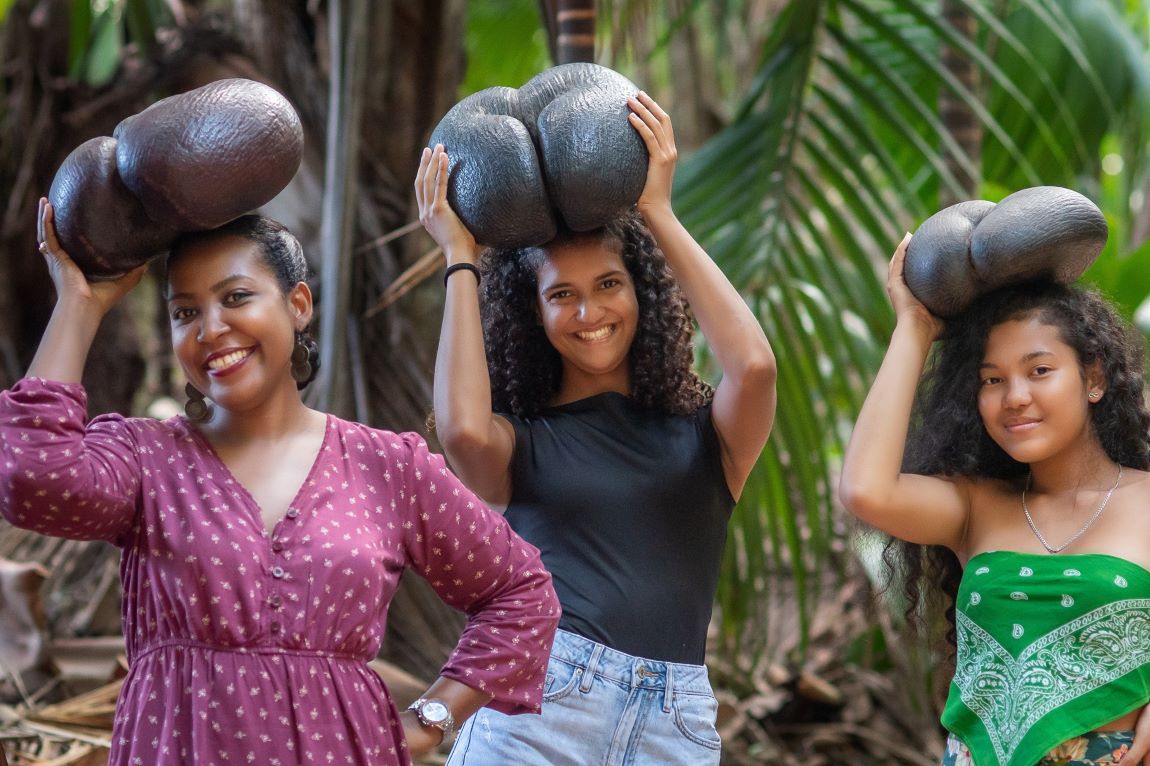By ‘Sandra Bonnelame
“…legend has it that on a night lit by a full moon, in a tiny jungle forest on the isle of Praslin in the Indian Ocean archipelago of the Seychelles, a rather bizarre mating ritual takes place between the forest’s principal inhabitants. Below the canopy, the jungle is enveloped in a misty sweat as the lovers, locked in rhythm, sway back and forth in a primitive dance, while palm leaves rustle and tiny blooming flowers float through the air in a dazzling finish to a mystical ceremony that will ensure the forest dwellers of generations to come… “
And so the story of the Coco de Mer goes, except the ‘lovers’ in this case happen to be ancient, endemic palm trees. Legend has it that those who saw the trees making love to each other either died or went blind. This tale is further strengthened by the fact that scientists and biologists alike have still not fully come to an understanding of how the pollination of the erotic nut occurs.
Often compared to a female’s buttock, its distinct shape, is the main reason for its admiration and as a tourist, this is the best souvenir of the Seychelles you could possibly take home. As the cultural symbol of the Seychelles the best place to see this rare nut is in its natural setting at the Vallée de Mai; home to the largest concentration of coco de mer trees in the world and also a UNESCO World Heritage Site on the island of Praslin.
The Coco de Mer palm is dioecious; it has separate male and female plants, with the nuts themselves weighing anywhere between thirty to seventy pounds!

For a tree to reach adulthood it can take up to forty years, however, it then takes another seven to ten years for the nut itself to fully grow and fall off the tree. To be allowed for sale it takes an additional ten years for it to dry.
While the fruit is edible, it is not commercially valuable in Seychelles itself but it has been known to be used in Siddha medicine, Ayurvedic medicine, traditional Chinese medicine and as a flavouring in Southern Chinese cuisine.
If you are thinking of committing to buying a Coco de Mer as a souvenir, it will be hollow from the inside as they have had their kernels scooped out, so as not to be implanted elsewhere. Although the process involves being sawn in half and then glued back together, its charming peculiar shape nonetheless remains intact.
With tales told as tall as its endangered palm, the famous Coco de Mer is truly the pride of Seychelles. So famous that great lengths are being taken regarding the conservation of this endangered palm species from nut poachers.
Very strict rules apply to it being taken out of the country, but the goose chase to find your perfect nut should be worth it as Seychelles is the only place on earth that the Coco de Mer grows. At a nice price too! You can expect to spend up to USD300 on the best ones, which might seem expensive, but there again it makes for one fantastic souvenir!
Although the worth of a Coco de Mer nut will depend chiefly on its quality and size, note that not all shops sell at the same price. So, look for a nut that fits your budget.
The question is where to look? Ideally, its place of origin, if visiting Praslin Island is on your itinerary. You might just hit the jackpot there where there are Coco de Mer nuts for sale at an Anse Lazio Restaurant and Bar called Bonbon Plume.
Make sure when you leave with your nut, you have a proper registration for it, as each is given an identification and green label with the main idea being to stop illegal poaching and conserve the few that remain. DO NOT BUY it if the supplier is unable to hand over the right papers, the government seal and export license. You will not be able to leave the Seychelles without these. Do not risk being fined or sent to prison!
So make sure you leave a considerable amount of space in your luggage on your return trip for this wonderful artefact from mother nature.
*****
Initially published as “Taking Home a Coco De Mer from the Seychelles,” this article was written by Sandra Bonnelame



